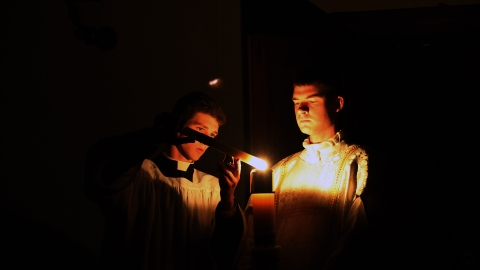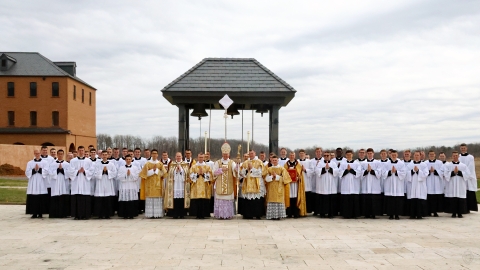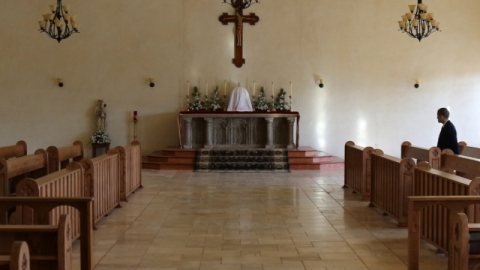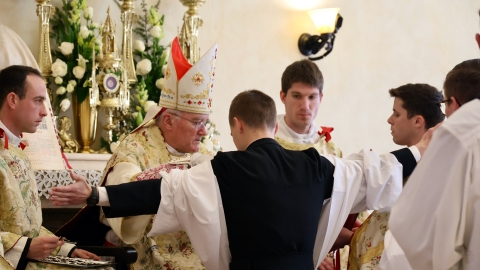Saying Good Bye to our Alma Mater

The inside story of the Seminary's move from Ridgefield to Winona in the Fall of 1988, written by a seminarian who lived through these events
Before the Society of St. Pius X (SSPX) heard of Winona, St. Thomas Aquinas seminary had a life of its own. The baby was born and bred for five years in the basement of St. Joseph’s Church in Armada, Michigan. In 1979 seminary moved to Ridgefield definitively, or so it seemed. Indeed, the rector, Fr. Donald Sanborn, was partial to the North East Coast.
Ridgefield has all the charm and mystique of New England. Besides the animals feeding on our veggie patch (nicknamed the deer salad bar), one of my fondest memories of visitors was a young John Rao. He always declined a free haircut, but would punctually give a Tuesday night two-hour shot of anti-liberal history in our refectory/classroom.
In 1983, after the exit of the so-called “Nine,” Fr. Richard Williamson took over the reins of the seminary in difficult circumstances. In 1984, Fr. Francois Laisney shouldered a reunited U.S. District, after the painful defection of Frs. Clarence Kelly (North East District) and Hector Bolduc (South West District). I vividly recall Fr. Franz Schmidberger, the Society’s Superior General, lamenting the odious exit of his newly ordained confreres. He was ready to write the American District off the SSPX map.
Yet, two years later, after trust in the Society’s founder, Archbishop Marcel Lefebvre, was regained, the seminary walls would not contain the incoming influx. Well into the year 1987, Verbum, the seminary magazine, was still writing about completing the seminary building in Ridgefield. Words had spread to search for other options. Dr. Frank Novak, our vibrant Chicago coordinator, scouted the Midwest. One day, he happened upon the Winona property. He came, saw and was conquered, saying: “It is a jewel.”
St. Peter the Martyr’s priory was built on Stockton Hill in 1949. It provided 92 bedrooms, with a large chapel and a huge refectory. But, 20 years later, the novitiate had vacated. The great Order of Preachers which had fought against heresy was assailed by changes in the Catholic Church and modernism. With their faith gutted out, the priory also soon empty, leaving behind only those resting in the cemetery.
The deserted priory was maintained for 15 years by former Dominican postulant Byron Bascle, watching over a “jewel” which attracted vandals. Moreover, the harsh Minnesota winters did not pardon the heatless building.
Peter Sardegna and Co, our Long Island coordinator, organized a large group of volunteers. They began sealing the roof, replacing the boilers, and, relentlessly tore down burst pipes, along with floor and plaster. 400 windows were eventually replaced and all the outer walls received fresh insulation. By early spring, Peter was relieved: “When we came, the building was soulless. Now, steam courses through its pipes again. She’s ready for battle. But now it’s up to the crew!”
Winona’s opening coincided with the 1988 Episcopal consecrations which I attended in the company to my rector. Getting back to New York, I recall writing in the next seminary letter: “Most fittingly, a new and excellent property is about to host a new Excellency.” Acting as Vice-Rector by default, I was involved with the first wave of pioneers to “seminarize” the new property, preaching a 30 day retreat with Fr. James Peek that August.
Our first impressions of Winona surpassed our dreams. As the dusty van rolled in through an impeccably groomed landscape, we felt we were entering a religious domain. The first Mass was celebrated in the small convent chapel, and soon, after nearly two decades of inactivity, the large chapel was in public use again.
On October 8, 1988, the seminary officially opened. The day was graced with Fr. Schmidberger’s assisting the newly consecrated Bishop Williamson, who blessed and sprinkled the outer and inner walls of the chapel in the midst of a jubilant crowd of faithful.





